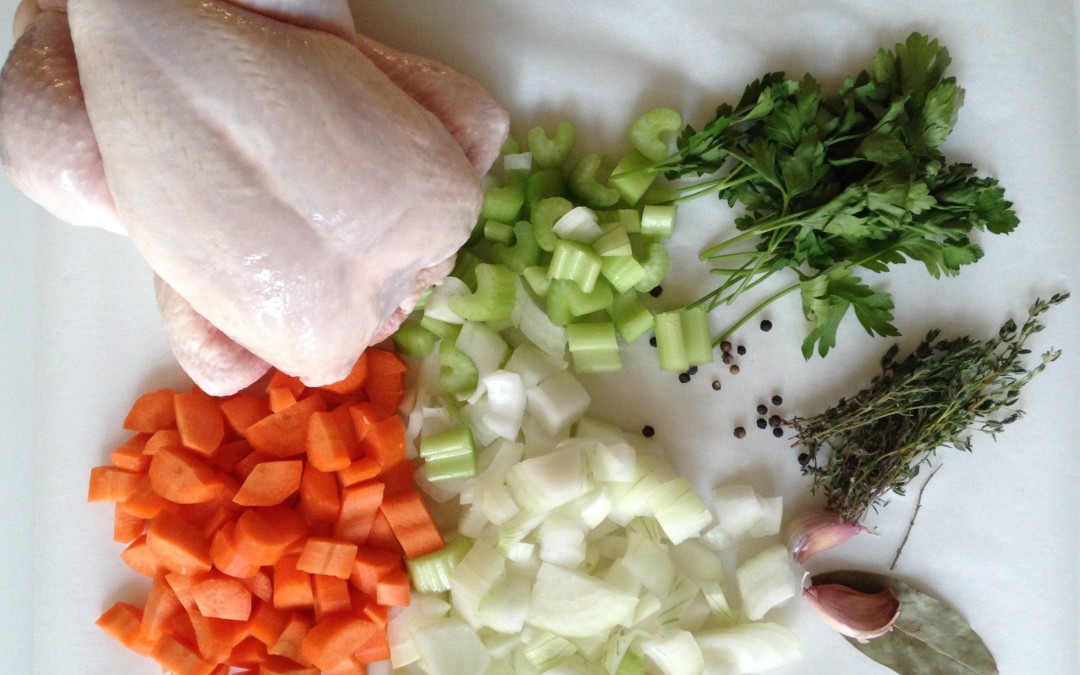Across the world wide web there are an abundance of recipes that use the terms stock and broth as if they are exactly the same thing. There is, of course, as with everything else on the internet, debates and chatter about the difference between the two. Through all of it though, there is really only one thing that matters – stock is the absolute best thing to have on hand when cooking. It is the best foundation for cooking sauces, soups and anything else. It is the blank slate upon which your dishes are best created. A good stock is like gold, no – platinum.
Why? Because of the gelatin it contains. This magical thickening agent gives body and mouthfeel to dishes that no broth can impart. Good cooking is good because of small subtleties and gelatin is one of these small subtleties that goes along way to making dishes great. Some will say that broth is simply seasoned stock. Or that broth is made of meat and vegetables and stock is made of bones. These things don’t matter especially since putting both meat and bones together to make a stock is the best way forward as it ensures great meaty flavor and gelatine-y goodness. Sure, all the trolls and chatterboxes are now saying “Well what about vegetable stock. I guess there can’t be vegetable stock if there is no gelatin. Vegetables have no gelatin.” While this seems like interesting chatter, it is a blog post for another day. We will get to this, but first we focus on classic non vegetable stocks.
How to Make Chicken Stock
We often think of stocks being used in restaurants and broth being used at home, but since it is relatively easy to make a good stock, why not make it for use at home. It does take time, but not that much – a great activity for a rainy day. And since the ingredients are simple and the technique is as easy as heating water, why not? Is it as convenient as buying a can of chicken broth at the store? No. But with only a little effort, you can prepare a nice stock of stock to have on hand for use anytime that is far tastier than anything that you will buy at the store. Plus, your stock will be a true blank slate. One that you can truly season and flavor to your taste. The store bought stuff, while fine in a pinch, comes with flavors and seasoning that you might not like or it may be just a tepid liquid with little flavor that needs more help than can be given or it may not add that much to the dish. When you reduce broth, you get salt and not much else. When you reduce stock you get glaze and a concentrate of rich flavors.
How To Make Chicken Stock – Brown or White?
The best stock to start with, and probably the one that is used most, is chicken stock. It is great to have on hand and very simple to make. There are two kinds to consider – a brown chicken stock where the bones, meat and vegetables are roasted first or a white chicken stock where the bones and meat are simply simmered. The brown stock will have richer flavor, but a white chicken stock will do great things in your dishes, too. How do I decide which to make? It comes down to time. The chicken needs to roast at least an hour in the oven to get everything nicely browned. The simmering takes about 2 hours. If I don’t have the extra time for the roasting, I make white chicken stock – an hour saved. Either way, I am never disappointed and I am glad to have a good stock on hand for my dishes. One addition to brown stocks is typically tomato paste. This is optional, especially when it comes to brown chicken stock. With brown chicken stock I usually skip it. With beef or veal I use it.
A Few Tips
Here are few things to think about when considering how to make chicken stock or any stock, really. (Don’t worry, they are just things to consider. Don’t go crazy thinking that making chicken stock is a big laborious undertaking. It is not.)
- Start with cold water. Why? Proteins dissolve at different temperatures. If you start cold and go up, you are more likely to dissolve all the most flavourful proteins by hitting the largest range of temperatures.
- Skim the foam. While it is not fully compulsory, classically, stocks are skimmed of the foam. This helps reduce impurities and off flavors and helps achieve clarity (of the stock that is). It is no big deal if you don’t get it all. A little cloud never hurt.
- Simmer gently. Stocks are not boiled, they are gently simmered to coax out the nuances of flavor from the meat, bones and aromatics.
- The chicken is the star of the show and the vegetables are just supporting. The vegetables used should weigh 15-20% of what the chicken weighs.
- Strain through the finest mesh you can. A flavorful, clear stock is the the gold standard. Straining is a big part of helping achieve a good clear stock.
- Cool as quickly as you can. This is just good food safety and hygiene. Use an ice bath to speed up the process.
- After it is cool, skim the fat. Fat has no place in the stock. It can be discarded.
- Portion and freeze. It keeps well frozen and for a few days in the fridge.
![]()
- 1 4-5 lb whole chicken like a roaster
- 1 large sweet onion – like a vidalia (about a 1/2 lb)
- 2-3 carrots (about a 1/4 lb)
- 2 ribs of celery (about a 1/4 lb)
- 10 sprigs of fresh parsley sprigs
- 10 sprigs of fresh thyme
- 2 cloves of garlic
- 1 bay leaf
- 10-15 whole black peppercorns
- water to cover – about 16 cups
- Peel the onion and roughly chop it into a large dice.
- Peel and chop the carrots into medium chunks.
- Chop the celery into medium pieces.
- Peel the garlic cloves.
- Wash the chicken under cold water.
- Place the chicken in a large pot. Cover with cold water so the chicken is covered with 2 inches of water.
- Turn the heat on and bring to a boil. As it comes up to temperature skim the foam that rises using a ladle or large spoon.
- Just as it starts to boil, drop the temperature to low and let it simmer. Add the rest of the ingredients. Simmer 2 hours skimming if needed.
- Strain the stock through a fine mesh strainer into a large heat proof container. Let cool. Reserve the meat. Discard the other solids.
- When it is cool enough, cover it and put it in the fridge overnight. A layer of fat will solidify on top. Scrape of the fat and discard it.
- Portion the stock into small quantities and freeze it. It is good for a few months in the freezer and about 3 days in the refrigerator.
- Yield – About 12-14 cups of stock.
- Back in the day, it was the older chickens or roosters that would be used as they would make the tastiest stock – these would be stewing chickens. Today, most chickens in the grocery will do. I use a roaster. It is best to use a whole chicken, but if I am making a stock with parts only I use wings.
- Start with cold water!
- This stock should be made in advance and frozen then used as needed. It can stay in the freezer a few months.
- In regards to skimming the foam, if you want the clearest, best stock possible, skim. I skim throughout, but if I don’t get all the foam and I don’t worry about it. A cloudy stock is not the end of the world.
- When considering the aromatic vegetables, onion, celery and carrot are best. If you like your stock a bit sweeter try parsnip, but be careful. It can be very sweet. A rough dice works best and no pre-cooking is needed. In other words, don’t sauté the vegetables in oil before adding the chicken. Just let the vegetables simmer in the water. Another rule of thumb to consider is the vegetables should be about 15-20% the weight of the chicken. The chicken is the star of the show and the vegetables are just supporting. So for a 5 pound chicken, use 3/4 to 1 lb of aromatic vegetables. The ratio is typically 50% onion, 25% carrot and 25% celery. There is no reason to be exact to the ounce. These are just rules of thumb to keep in mind.
- The meat from the chicken is perfectly good after simmering! Don’t waste it! Use it soups, pot pies, etc – delicious!
- 1 4-5 lb whole chicken like a roaster
- 1 large sweet onion – like a vidalia (about a 1/2 lb)
- 2-3 carrots (about a 1/4 lb)
- 2 ribs of celery (about a 1/4 lb)
- 1 heaping tbsp tomato paste (optional)
- 10 sprigs of fresh parsley
- 10 sprigs of fresh thyme
- 2 cloves of garlic
- 1 bay leaf
- 10-15 whole black peppercorns
- vegetable oil
- water to cover – about 16 cups
- Preheat the oven to 400F.
- Quarter the chicken separating all the pieces. Wash under cold water. Rub the chicken pieces with vegetable oil.
- Peel the onion and roughly chop it into a large dice.
- Peel and chop the carrots into medium chunks.
- Chop the celery into medium pieces.
- Peel the garlic cloves.
- Toss the vegetables with vegetable oil then (optional) the tomato paste.
- Roast the chicken in the oven in a roasting pan for 30-40 minutes. Add the vegetables and continue roasting another 30-40 minutes until the the chicken is brown and the vegetables are roasted and getting caramelized. (The chicken and vegetables may not be fully cooked, this is fine. The full cooking will happen in the stock pot.)
- Transfer the roasted chicken and vegetables to a large pot. Cover with cold water so the chicken is covered with 2 inches of water. If there are any tasty bits in the roasting pan, scrape them up using a little water and add them to the pot.
- Turn the heat on and bring to a boil. As it comes up to temperature skim the foam that rises using a ladle or large spoon.
- Just as it starts to boil, drop the temperature to low and let it simmer. Add the rest of the ingredients. Simmer 2 hours skimming if needed.
- Strain the stock through a fine mesh strainer into a large heat proof container. Let cool. Reserve the meat. Discard the other solids.
- When it is cool enough, cover it and put it in the fridge overnight. A layer of fat will solidify on top. Scrape of the fat and discard it.
- Portion the stock into small quantities and freeze it. It is good for a few months in the freezer and about 3 days in the refrigerator.
- Yield – About 12-14 cups of stock.
- Back in the day, it was the older chickens or roosters that would be used as they would make the tastiest stock – these would be stewing chickens. Today, most chickens in the grocery will do. I use a roaster. It is best to use a whole chicken, but if I am making a stock with parts only I use wings.
- Start with cold water!
- This stock should be made in advance and frozen then used as needed. It can stay in the freezer a few months.
- In regards to skimming the foam, if you want the clearest, best stock possible, skim. I skim throughout, but if I don’t get all the foam I don’t worry about it. A cloudy stock is not the end of the world.
- When considering the aromatic vegetables, onion, celery and carrot are best. If you like your stock a bit sweeter try parsnip, but be careful. It can be very sweet. A rough dice works best and no pre-cooking is needed. In other words, don’t sauté the vegetables in oil before adding the chicken. Just let the vegetables simmer in the water. Another rule of thumb to consider is the vegetables should be about 15-20% the weight of the chicken. The chicken is the star of the show and the vegetables are just supporting. So for a 5 pound chicken, use 3/4 to 1 lb of aromatic vegetables. The ratio is typically 50% onion, 25% carrot and 25% celery. There is no reason to be exact to the ounce. These are just rules of thumb to keep in mind.
- Regarding the tomato paste, this is optional. If you choose to use it, you don’t have to roast it although this gives it a rich flavor. You can add it with the aromatic herbs when the simmering starts.
- The meat from the chicken is perfectly good after simmering! Don’t waste it! Use it soups, pot pies, etc – delicious!
For a general outline of the steps for making other types of white or brown stock please visit our Kitchen Confidence: How to Make Stock page.
![]()
Keep Eating! Keep Innovating!
How do you make chicken stock? Are you a stock person or a broth person? Let us know in the comments or on Facebook.
The Culinary Exchange can also be found on Twitter, Instagram, Pinterest, Google+ and YouTube.
![]()






Trackbacks/Pingbacks